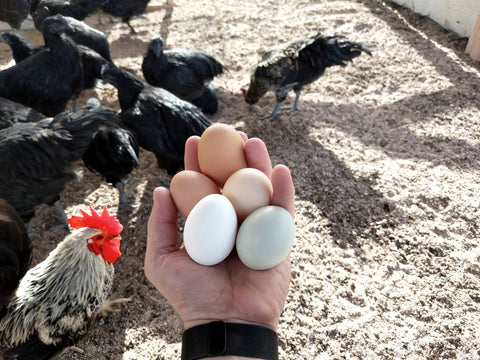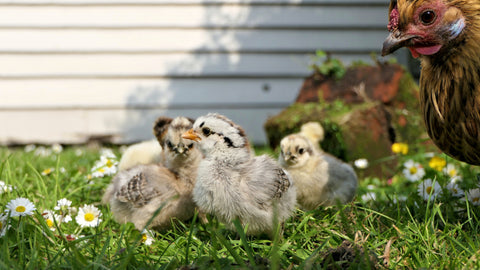Ensuring a balanced diet for your hens is vital for their long-term health and consistent egg production. A well-nourished diet not only promotes optimum health but also guarantees high-quality eggs with delicious flavour!
What exactly is chicken food?
Chicken food is a specially formulated selection of raw ingredients that are combined with a specific range of minerals and nutrients. These ingredients are tailored to the needs of chickens. However, just as different types of food that humans eat can either support or destroy our health and well-being, so too can a chicken’s food.
Nutritional requirements of laying hens
There is a very useful break-down of the nutritional requirements of laying hens on the PoultryHub site. It details the six main classes of nutrients needed which are:
- Carbohydrates: the main source of energy needed to support chickens as they go about their daily activities of preening, foraging, playing, perching, dust bathing, and the like.
- Fats: provide both essential fatty acids needed for a number of processes within the chicken’s body along with energy.
- Proteins: needed for the building of muscle and other body tissue along with feather and egg development.
- Vitamins: organic chemicals containing carbon that help control the chicken’s bodily processes and are needed in small amounts for the health and growth of the bird.
- Minerals: inorganic chemicals not containing carbon that also help control body processes and are needed for health and growth.
- Water: clean, fresh H2O to hydrate chickens
Of course, there is a lot more than just the chicken food that your hens are fed that determines egg quality and production. Each breed (and strain of breed) produces varying quality of eggs in varying amounts at varying times.
Hen breed
Purebred hens such as the Rhode Island Red, Australorp or Silkie vary greatly in size and egg laying ability. Some purebreds have a strong tendency to go broody and want to sit on eggs all day. They will stop laying eggs when broody, which obviously isn’t too good for your egg production!
Hybrid laying hens such as the ISA Brown, Hy-Line Brown and Lohmann White, start laying eggs sooner than most purebreds. They don’t tend to go broody, but do start to slow down after their first egg laying season. However, in their first 18 months, they are able to lay the equivalent number of eggs that many purebred hens would only manage to lay over four or five years!
This high level of egg production with modern hybrid layers is only possible due to an egg-focused breeding program over many decades. The hybrids can only support their heightened egg production traits based on very specific nutritional needs, which can often be quite different to purebred hens. To gain an appreciation of the detailed nutritional and management needs of a modern laying breed just take a look at the Hy-Line Hen Management Guide.
Important factors that affect the nutritional needs of chickens
The particular breed or strain of chicken is extremely important. Some breeds will have a larger or smaller body size or a faster or slower growth or egg production rate. Different breeds will also absorb and use nutrients from their feed with varying levels of efficiency. Because of this, each breed will need a feed with a different composition of nutrients.
On top of this, the genetics of commercial laying hens is constantly changing and evolving, requiring an alteration of their nutritional needs. This is why we always check with our poultry nutritionist for any tweaks and changes needed in our feed recipe over time. This is essential in order to keep our feed perfectly matched to the needs of the latest breeds and strains of laying hen.
Laying hen nutrient requirements are also related directly to both their body weight and their stage of maturity. Before they reach sexual maturity, the hen and rooster have only small differences in their nutrient needs. However, significant changes to the nutritional composition of feed is needed following the onset of sexual maturity with each sex needing very different feed ration formulations from this point forward.
Reproductive state
The level of egg production in laying hens and sexual activity in roosters will affect nutrient requirements. Ambient-temperature chickens have increased energy requirements to maintain normal body temperature in cold conditions (such as during winter), and lower needs in hot conditions (such as in summer). The act of digesting food also produces body heat, which will vary according to the nutrient composition of the diet. This is known as the “heat increment” of the chicken’s diet.
Housing system used
The type of housing used for chickens will also have a large effect on the birds’ activity levels and in turn their energy needs. For example, hens in a cage system have much lower energy needs than active free-range or backyard hens able to roam.
Diseases and parasites
Chickens suffering from an ailment, disease or parasite issue may benefit from an increase in the intake of some nutrients, most commonly vitamins. This is why we have developed our Vitality Booster product to support hens experiencing a health or wellbeing challenge.
Specific needs
Finally, a laying hen diet may be optimised depending on specific production needs such as weight gain for a pullet, egg production rates, or egg size. On the other hand, poultry that are raised for breeding purposes may need their energy intake limited to make sure that they don’t become obese.
Chicken food isn’t simple! So, as you have now learned, there are quite a number of factors that determine not only what a chicken needs from their nutrition but also what nutrition is needed to support their breed, physical environment and health. For more information, go to the top right-hand side of any of the Talking Hens website pages and sign up for our Free eBook. It contains a wealth of information and details all of the breeds in Australia.







Comments (0)
There are no comments for this article. Be the first one to leave a message!